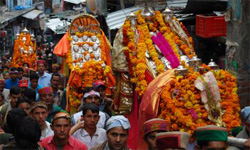| Kullu Dussehra |
 |
While Dussehra is celebrated with great enthusiasm and fervor by burning effigies of Ravana, Kumbhkarana and Meghnath in various parts of the country, the unique Kullu Dussehra is a festival with a difference, devoid of such features. The festival has been declared an international event by the state government and colorful cultural programs by local, state, national and international troupes mark the evenings.
The weeklong colorful festival starts on the day when Dussehra celebrations conclude in other parts of the country and all activities revolve around the presiding deity "Lord Raghunathji".
|
 |
The entire Kullu town, especially the sprawling Dhalpur Maidan which is converted into temporary abode of Lord Raghunathji, vibrates with colorful celebrations with a strong blend of religious faith.
The festival begins with the arrival of image of Goddess Hadimba from Manali and about 200 local "Devtas", accompanied by a host of
|
attendants who reach the venue in colorfully decorated palanquins to pay homage to Lord Raghunathji.
The image of Lord Raghunathji is brought from Sultanpur temple located in the palace of erstwhile Raja of Kullu and taken in a procession. All the local “Devtas” join the procession and devotees pull the ropes of flower-bedecked chariot of Lord Raghunathji as it is considered auspicious and brings fortunes and prosperity.
The Goddess Hadimba returns to her abode Manali after “Lanka Dahan” and Lord Raghunathji also returns to the temple. No effigies of Ravana, his brother or his son are burnt, but five animals are sacrificed at the banks of Beas river as "Lanka Dahan". The local “Devtas” also leave for Dhalpur and from there to their respective villages as the curtain falls on the festival.
According to the famous legend about Kullu Dussehra, a former ruler of Kullu, Raja Jagat Singh had once gone on pilgrimage to Manikaran and was wrongly told that a local Brahmin Durga Dutt had hoard of fine pearls.
He sent his men to ask Dutt if he would sell some of the pearls. When the Brahmin said he had no such pearls, the king’s men started beating him and to escape the blows, the Brahmin said he would give the pearls when the king returned from Manikaran.
|
 |
When the King returned, his men again went to the Brahmin who locked himself and his family in the house and set it ablaze. When the house was engulfed by flames, Dutt climbed to the roof and with a sharp-edged knife started inflicting wounds on his body.
"O’ King, here are the pearls", he cried and threw pieces of flesh from his body. Jagat Singh, who watched the horrible scene, lost his peace of mind and was not able to perform his duties afterwards.
Later, a holy man advised him that the only way
|
to get relief was to get the image of "Lord Raghunathji" from Ayodhya and worship it. The holy man sent one of his disciples to Ayodhya to bring the image of Lord Raghunathji.
On arrival of the image, Singh and his family paid homage to the Deity and the King declared that henceforth, it will be righteous rule of Raghunathji in the kingdom while he and his descendents would only act as regents.
|
|
|
| Religions |
In India, religion is a way of life. It is an integral part of the entire Indian tradition. For the majority of Indians, religion permeates every aspect of life, from common-place daily chores to education and politics. Secular India is home to Hinduism, Islam, Christianity, Buddhism, Jainism, Sikhism and other innumerable religious traditions. Hinduism is the dominant faith, practised by over 80% of the population. Besides Hindus, Muslims are the most prominent religious group and are an integral part of Indian society. In fact India has the second largest population of Muslims in the world after Indonesia.
|
| Read more about Indian Religions |
|
|
